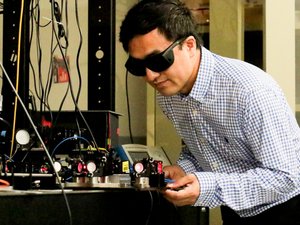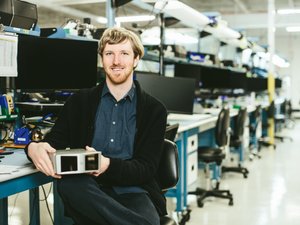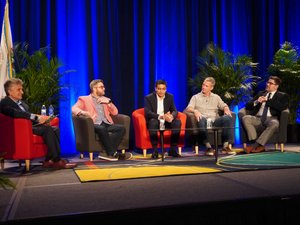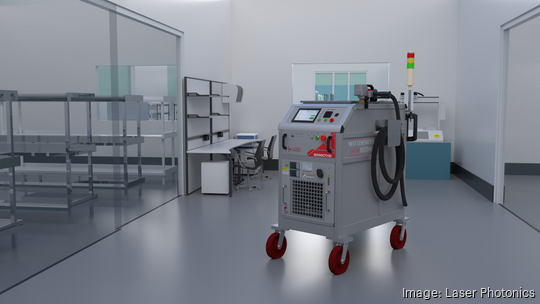
Maitland-based Laser Photonics went public last year (Nasdaq: LASE), and since then, the company’s marketing department has staffed up.
The company hired 30 workers and promoted Seth Bush — who previously was marketing manager — to marketing director. Now, the firm is poised to grow more, this time in the production arena.
Laser Photonics is eyeing an undisclosed property near the University of Central Florida, and plans to close a deal this year so it can add a third facility to its Central Florida footprint, said Bush. The firm's other two offices are in Maitland.
Bush did not reveal whether the company intends to lease or buy property near UCF. However, the firm is seeking this much-needed new site for its manufacturing operations, since it has been rolling out new laser-powered cleaning tools all year, Bush told Orlando Inno.
Why this matters: Photonics companies led other types of manufacturers in job growth, according to an Orlando Business Journal analysis of last year’s industry job announcements tracked by the Orlando Economic Partnership. Photonics is a $780.4 billion global industry, so groups like Orlando-based Florida Photonics Cluster advocate for Central Florida to get a bigger piece of that pie, which can lead to more jobs and more economic impact here.
Photonics is the science of light waves. Some of the strongest business segments founded on photonics are brain imaging, photonic sensors, non-destructive testing equipment, laser diode semiconductors, night vision and photonic integrated circuits, per industry trade publication Novus Light Technologies Today.
Laser Photonics was founded in November 2019 and announced its initial public offering on Sept. 29, 2022. According to the company's most recent quarterly SEC filing, Laser Photonics' net revenue for the three months ended June 30 was $968,049, down by almost $400,000 compared to the same period in 2022. The firm's stock was trading at $2.12 per share as of the afternoon of Sept. 11. The high at that time was $2.57 per share, and the 52-week high is $7.23.

Orlando Inno met with Bush at the company's headquarters office to learn more about Laser Photonics’ recent growth and what’s to come. Here are some highlights from what he shared:
What happens in each of your locations?
Here in our main office, 90% of the team is marketing and there’s a small group of salespeople. Down the street, we have our manufacturing facility, and research and development. We're also looking at another location closer to UCF to expand our production abilities. We already have a building in mind and we’re working on a contract. Right now, we have right around 100 employees. I don’t know how many we’ll add on the production side.
When Laser Photonics went public, why did it decide to build up marketing?
There wasn't a large focus on marketing before that initial public offering. Massive growth of the marketing division was needed to manage new product launches. Our marketing capabilities have expanded substantially, and the whole marketing team is here in Maitland.
Are there unique marketing challenges in your industry?
Finding the right customer on the industrial side is like finding a needle in a haystack. We do targeted efforts both by vertical and by products. So whether it's automotive, aviation or shipbuilding, we do targeted campaigns specifically tailored to them. All the campaign assets are created here. We used to outsource the work but we brought it in-house.
What’s the best way to reach your ideal customer?
It’s an education process, with laser products like ours being new to the industry.A lot of people don’t know about it, so we reach them through all means: Digital ads, search ads, email marketing, print advertising. We also have our own call center locally reaching out to perspective customers. We have white papers that are pushed out to trade publications. We use all the social media channels available.
Is there certain content that rises to the top in terms of effectiveness?
We make videos. We've also added a lot of augmented-reality 3D models. Some of our products are extremely large, and showing customers those kinds of tools as a 3D model is most effective. We take the CAD [computer-aided design] drawings from the engineers and visualize those into 3D scans.
What new products has Laser Photonics designed and manufactured?
There are a lot. We’ve emphasized our CleanTech laser systems that remove rust, corrosion and contamination from a wide variety of surfaces and materials. Our laser is dual access, meaning it is multidimensional and cleans surfaces with ridges or other variations — it doesn’t have to be a flat surface. We have versions for cleaning a huge range of objects and machines.
Can you share some laser cleaning examples that can help readers understand your products?
Let’s say you’re laser cleaning a surface contaminated with lead paint or you’re decommissioning a nuclear reactor. After the cleaning is done, there are no byproducts. The material you cleaned off is gone. There’s nothing to dispose of; no remaining environmental hazard. Or you might have a classic car you’re restoring. You can clean the surface, removing rust and anything else. You can clean the engine without taking it apart and without risking damaging it, which is especially important if it’s irreplaceable.
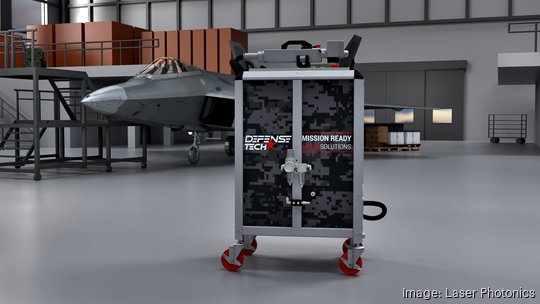
Who is your competition?
We’re going to significantly disrupt the sandblasting industry. Regulations are coming down to address health concerns resulting from sandblasting. Airborne particles can get encased in your lungs, and laser cleaners don’t cause that outcome. There are also environmental concerns with sandblasting and chemical cleaners. If you sandblast a nuclear facility, what’s left is a pile of radioactive sand, and then you have to dispose of that.
Photonics by the numbers
Central Florida boasts 130 photonics companies, 13,000 employees and a $3.5 billion impact in the region, according to the Florida Photonics Cluster, an Orlando-based nonprofit membership organization. Photonics is expected to grow from its current $780.4 billion to $921.66 billion in global revenue by 2028.
For more stories like this one, sign up here for Orlando Inno newsletters from the Orlando Business Journal and the American Inno network. And be sure to follow us on LinkedIn, Facebook and Twitter.

